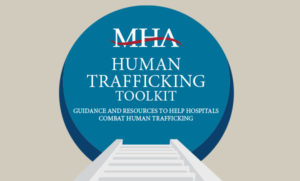MHA, AGO Release Human Trafficking Toolkit
MHA Contact: Sarah Willson

MHA and the Missouri Attorney General’s Office collaborated to develop resources for Missouri hospitals to combat human trafficking. It is estimated that 88% of sex trafficking victims encountered the health care system while being trafficked. Less is known about those being trafficked for labor and their interaction with the health care system. However, labor trafficking can include individuals forced to engage in a wide variety of tasks from farm, construction and factory work, to retail and restaurant work. As with those involved in sex trafficking, there is no specific profile.
While several hospitals have implemented policies and procedures related to human trafficking, many are looking for resources to inform the development of such policies, procedures and staff education.
MHA convened a group of experts from Missouri hospitals and the AG’s Human Trafficking Taskforce to form the Hospital Human Trafficking Taskforce. This group met throughout several months to develop the Human Trafficking Toolkit, as well as 14 online education modules related to trafficking.
Hospitals can use the toolkit to formulate multidisciplinary teams to develop policies and procedures for the identification and treatment of trafficking victims. In addition, the on-demand availability of the modules will make the staff education process efficient and cost-effective.
MHA plans to assess hospital utilization of the toolkit and online modules. Similar collaboratives have been established in other states, including Nebraska, Kansas and Illinois. Hospital emergency departments and urgent care centers are mandated in Section 595.120, RSMo., to display posters on human trafficking, including the hotline number. Posters are developed by and may be obtained from the Missouri Department of Public Safety.

Vaccine Hesitancy and the Ongoing Fight with COVID-19
By: Erik Frederick
Chief Administrative Officer
Mercy Hospital Springfield
In southwest Missouri, COVID-19 is challenging local health systems at levels not seen during the entire pandemic. The second surge for Mercy Hospital Springfield started on June 1, 2021, with a COVID-19 census of 26. The census on July 9, as I’m writing this, is 128. In the past 39 days, the census rose above the highest single-day count of 113 on Dec. 28, 2020. It took 150 days to reach the peak in the first surge, but only 39 days to reach and exceed that number in the current surge. By the time you read this, it is very likely our new record will be broken several times over.
There are three main factors driving this escalation. First, is the Delta variant, which is more contagious than the Alpha variant originally identified in England. Those infected with the Delta variant can potentially spread the disease to up to eight people, as compared to the earlier version which could potentially infect up to two people. The Greene County Health Department has estimated that over 90% of new COVID-19 cases are attributed to the Delta variant.
Second, precautions that were in place during the first surge are no longer present. Masking and social distancing are no longer mandated, and many individuals in the community are choosing not to follow those safety precautions anymore. It is summer in the Ozarks. Tourism is high, restaurants are open to full capacity and the public is making up for a lost summer in 2020.
The third and most impactful reason for the unmitigated spike in positive cases, falls squarely on the shoulders of the unvaccinated. It is well-documented that vaccination acceptance rates in southwest Missouri are some of the lowest in the state and country. In Greene County, home to both Mercy Hospital Springfield and CoxHealth South, the vaccination rate is 38%. The surrounding counties that we serve are even lower — some in the teens.
Unvaccinated individuals currently represent 95% of the inpatients at Mercy Hospital Springfield. The few vaccinated patients that have been admitted remain at the lowest level of care with none in the ICU at the time of this letter. Compounding the issue is that 40% of inpatients are below the age of 60. Not surprisingly, this is the same group with the lowest vaccination acceptance. In the current surge, we are seeing patients in their 20s, 30s and 40s in the ICU, ventilated and dying. There are pediatric patients, laboring mothers and otherwise healthy individuals admitted specifically for COVID-19. We did not experience this during the initial surge, as many of the very ill COVID-19 patients were 60 and older with multiple existing health conditions.
Clearly the path forward and away from COVID-19 is through vaccinations. We must continue to educate our communities that this virus will be a disruption to everyday life until all eligible persons get the vaccine, which is safe, effective, available and free. We must move away from protecting personal choice to protecting the common good and move forward as a united community.
COVID-19 Status in Missouri
MHA Contact: Mat Reidhead or Jackie Gatz
On Aug. 6, Missouri hospitals reported 2,136 patients hospitalized with suspected or confirmed COVID-19. This is nearly three-quarters of the volume hospitals experienced during the peak surge of December 2020 and January 2021, which took approximately nine months to reach. The current Delta variant-driven wave has occurred much more rapidly, with statewide hospitalizations increasing more than 200% since June 1.

Missouri Supreme Court Affirms Medicaid Expansion Amendment Constitutionality
MHA Contact: Jane Drummond or Daniel Landon
On July 22, the Missouri Supreme Court upheld the will of the voters and ensured access to health care for approximately 275,000 Missourians. The decision came after expedited litigation to compel state officials to implement Medicaid expansion. On May 13, citing a lack of budget authority from the General Assembly, the Department of Social Services withdrew the proposed State Plan Amendment previously submitted to the Centers for Medicare & Medicaid Services for expansion. Three individuals eligible for benefits under constitutional Amendment 2 filed suit.
After a hearing, the Cole County Circuit Court ruled Amendment 2 was unconstitutional because it lacked a funding source. Article III, § 51 of the Missouri Constitution states the initiative process may not be used to appropriate funds unless the measure supplies its own source of revenue. The court reasoned that Amendment 2, by practical necessity, requires additional funding to cover the expansion population and therefore violates Article III, § 51. Because the case was decided on constitutional grounds, it was appealed directly to the Supreme Court.
The Court unanimously ruled that Amendment 2 is constitutional under a plain text reading of the appropriations bills. As of July 1, the expansion population was entitled to benefits on the same terms as the pre-expansion population, and nothing in the enacted budget bills altered or restricted the former group’s entitlement to benefits.
Lawyers for the state argued that several contextual cues signaled the General Assembly’s intent to forego expansion funding. First, the appropriations bills contain no reference to the enhanced federal matching funds available under expansion. Second, the legislature considered and rejected numerous bills that would have expressly provided the estimated dollars necessary to fund expansion, including the governor’s recommended budget. However, the Court determined it need not consider legislative intent when the language of the appropriations bills was clear and unambiguous.
The Court remanded the case to the Cole County Circuit Court to issue an order in favor of the plaintiffs and provide specific relief. On Aug. 10, the court issued a final order enjoining the state defendants from declining to enroll individuals made eligible by the constitutional amendment. The order further prohibits the state from imposing any greater or additional burdens, or eligibility restrictions on the expansion population. Gov. Parson issued a statement identifying immediate challenges to implementation, which include the need for additional staffing and computer system modifications. While the statement affirms individuals may begin to apply for expansion coverage through MyDSS.mo.gov, it cautions processing could be delayed for up to 60 days. Although eligibility determinations may be delayed, once approved, coverage is retroactive to the date of application.
MHA developed a guidance and resource toolkit to help its member hospitals assist potential enrollees apply for expansion coverage. The guidance will evolve to reflect changing circumstances and best practices. Also, MHA is part of a coalition that is promoting coverage and enrollment assistance.
PAC Campaign Is Underway
MHA Contact: Christy Carel

MHA’s political action committee fundraising campaign is an important component of the association’s advocacy program.
MHA supports three PACs — HEALTHPAC contributes to state-level candidates, AHAPAC is the PAC of the American Hospital Association that contributes to federal candidates and PAC of MHA also contributes to federal candidates. These PACs allow the hospital community to speak with one unified voice and support candidates who understand the complex issues hospitals tackle each and every day.
MHA’s 2021 fundraising campaign has a member-hospital goal of $100,000 for HEALTHPAC and $52,700 for AHAPAC. To meet this goal, it is essential for individuals from each member hospital, including hospital trustees, to participate. The 2021 campaign kicked off in early June, and we encourage you to contact your hospital CEO about participating.
Thank you for the important work you do on behalf of your hospital and community.
AHAPAC may accept contributions only from managerial employees, including trustees. Anyone may contribute to HEALTHPAC. Contributions are voluntary, and individuals are free to refuse to contribute without reprisal.

Board of Trustees Orientation Manual
MHA’s Board of Trustees Orientation Manual can be customized for your hospital. The document is a Microsoft Word template that enables you to quickly and easily add and delete content to modify the manual to fit your organization’s unique needs.

Roles & Responsibilities of Hospital Board Members
To remain engaged and successful in the leadership role, board members are encouraged to sharpen old skills and acquire new ones. This resource provides guidance on governance trends, barriers and best practices.

Sample Board Job Descriptions
MHA offers a sample job description for both a board chair and board member. Using the Microsoft Word template, these job descriptions can quickly and easily be modified to fit your organization's unique needs.
Education
Aug. 17 — The Great Resignation: Why Turnover Is Rampant as the Pandemic Subsides and What Organizations Can Do About It
Recent national surveys show that employees are quitting their jobs or considering doing so in record numbers. The reasons for this “Great Resignation” are many, including economic, organizational and psychological factors. Having a clear understanding of these reasons will enable organizations to better retain top talent during increased competition. Learn more.
Sept. 9 — Washington Update: Where Do We Go From Here?
A new administration has taken over in Washington, D.C., during a national health crisis. This session will highlight the primary goals for President Biden and his new Cabinet members. This program also will provide the dynamics of the changes that are finalized by CMS for federal fiscal year 2022, which will take effect Oct. 1, 2021. Learn more.
On-Demand Education
The MHA Health Institute offers cost-effective learning opportunities for both members and nonmembers to help them understand and address emerging issues, learn and share best practices, and comply with legal and regulatory requirements. Learn more.









